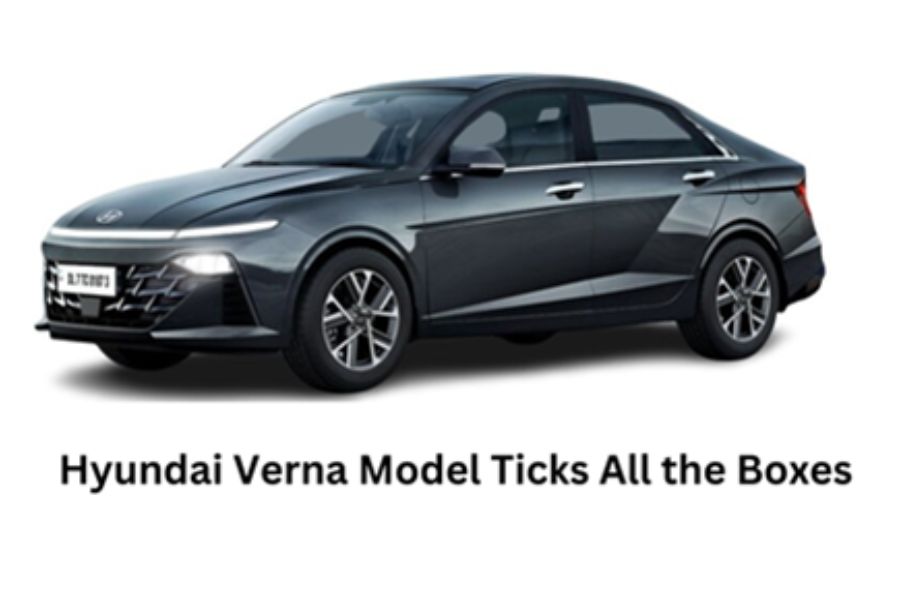Sedans continue holding appeal amongst buyers preferring the sweeping silhouette hiding practical interiors rather than the butch profiles of SUVs. Spaciousness, coupled with feature richness, even in lower trims, has an allure for Indian audiences looking past basic mobility. The Verna from Hyundai manages to hit the sweet spot owing to an expansive cabin and contemporary hi-tech gains, uplifting the in-car experience.
Positioned as a more premium offering over mainstay models like the Honda Amaze and Maruti Dzire, Hyundai equips the latest Verna with segment-leading equipment, lively powertrains and the credibility of a renowned after-sales network to emerge as a complete sedan. So what gives the Verna its unique appeal and should it make your consideration if eyeing a sedan upgrade? Let's find out.
Riding high on the success of SUVs like the Creta and Alcazar, Hyundai is transitioning its bold design language to sedans like the new Hyundai Verna. Fronting the lifted face is a blackened parametric grille design flanked by LED headlamps and DRLs reminiscent of elder siblings. Equally contemporary styling elements like connected LED tail lighting, coupe-inspired greenhouse shape and 16-inch diamond cut alloys build on the striking road presence from every facet.
Contrast-coloured roof options, brake callipers visible through sporty black wheels, and twin exhaust mufflers dial-up Verna's sporty aspirations. Flared wheel arches housing wider tyres substantially enhance the planted and hunkered-down feel compared to preceding generations. Overall, Hyundai has lent the new Verna an exciting road presence, which turns heads rather than staying vanilla like typical mid-size offerings.
The Verna's transformed exterior is matched by an uplifted interior ambience, feeling several segments above in places. Beige leatherette upholstery lends a sophisticated aura, complementing the airy cabin feel courtesy of a sunroof provision. Two-tone metallic interior trim flows across the width of the dash before culminating at aircon louvres.
Front passengers get the premium touch via powered seats with ventilation and heating functions.
An electric parking brake button, wireless phone charging pad and 360-degree parking camera add to the hi-tech provisions embedded within the thoughtfully designed cabin. The gloss black centre fascia is dominated by a touchscreen presiding over the latest BlueLink-connected technology, premium audio setup and multi-zone climate control settings.
Lots of legroom and headroom for all occupants is another strong suit of the Verna, thanks to reshaped seats and an elongated wheelbase. Boot space is also class-leading at 528 litres, and loading lip height stays manageable, making this sedan practical. On the whole, Hyundai has created a welcoming space for drivers and passengers loaded with features and comfort for memorable road trips.
Hyundai offers customers the choice between petrol engines catering to either regular commuting needs or outright performance, depending on the variant. The familiar 1.5L naturally aspirated 4-cylinder petrol engine puts out 113bhp directed via 6-speed manual or IVT auto boxes focused on drivability and efficiency. For enthusiastic drivers, a sportier 1.5L turbo-petrol generates 157bhp channelled through 6-speed manuals or 7-speed DCT gearboxes for punchy getaways.
Low-end torque and responsiveness are noticeably stronger in the turbo petrol, but even the naturally aspirated unit stays refined if driving in a measured fashion. With an ARAI-certified economy of 20 km/l from even automatic turbo variants, the running costs seem reasonable. Overall, the engines strike a good balance between real-world potency and subdued bills at the pump, contributing to the Verna's versatility.
In line with its premium positioning, Hyundai has equipped the Verna with an essential safety kit including 6 airbags, ABS, stability control and a rear camera, even in base variants. Higher trims also integrate additions like an electronic differential lock, hill-start assist, vehicle stability management, front and rear ultrasonic sensors, plus emergency stop signals.
But Hyundai goes further via ADAS tech comprising lane centring, automatic emergency braking, adaptive cruise control and blind view monitoring systems. These partially autonomous driving aids intervene when necessary to avoid collisions, improving onboard confidence considerably during highway trips. On the whole, Hyundai has addressed both active and passive safety requirements reasonably.
The Hyundai Verna makes a convincing case as a sedan upgrading practicality and premium feel in one swoop. The coupe-inspired exterior cuts a distinctive profile compared to rivals, while the uncluttered and airy cabin uplifts the in-car experience. Packed with provisions enhancing comfort, entertainment and connectivity, the interior treatment belies pricing.
Available in both traditional manual and efficient automatic transmission options, the engines offer peppy performance in today's context. Moreover, the strong standard safety specifications, along with optional ADAS technology, make the Verna a sensible investment rather than just an emotional buy. For customers eyeing a sedan embracing style and substance via modern touches, the transformed Hyundai Verna warrants a test drive.
Disclaimer: This is a sponsored article and does not involve any editorial input. The views expressed, including any statements, views, opinions, announcements, declarations, or affirmations are neither supported, nor endorsed by The Telegraph Online.











